Adaptive exercise programming is an often overlooked aspect of becoming an inclusive and well-versed fitness professional. People with physical, developmental and traumatic impairments deserve every opportunity to participate in safe and supportive movement practices and, here at ACE, we hope to inspire a community of professionals that are prepared to train and coach people of all abilities. So, when we came across ACE Pro Emily Kramer and the small-group adaptive training program she created at her gym, Kaizen Athletics, we thought we'd ask her some questions about how she develops her adaptive exercise program and why it's so important to her.
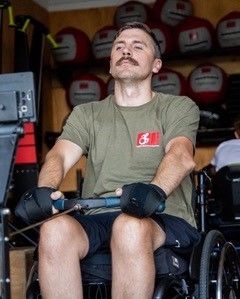
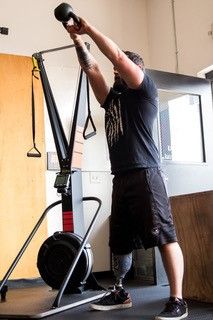
(Photos Courtesy of Kaizen Athletics)
ACE: What inspired you to start an adaptive training program?
Emily: It all stated when I went to a local fitness event where they were holding multiple workouts throughout the day to honor fallen soldiers. Virginia Beach is a big military town so our community is always working together to give back to our veterans, wounded warriors and their families. The workout that I participated in had a handful of upper and lower extremity amputees and they were doing the workout with me! I’ll never forget them doing box jumps next to me, running with their blades, deadlifting a barbell with modalities wrapped around their chests. I was blown away by their ability to work around their impairments. I was also moved by their mental fortitude. Making the choice to not use their impairments as an excuse either. I knew at that moment I needed to give back to this population and create a space where adaptive athletes can come in for fitness, friendships, education, mindset, and a sense of community. My first adaptive athlete was a veteran with a spinal cord injury. We helped him regain his independence again. Fast forward to today, we have a wide variety of adaptive athletes that we meet with 3x a week. Our program is called Kaizen Adaptive Training.
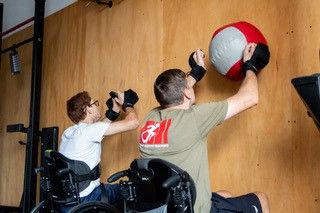
(Photo Courtesy of Kaizen Athletics)
ACE: Who is your adaptive program made for?
Emily: Kaizen Athletics provides an all-inclusive training facility for individuals with long-term physical or traumatic impairments (visible/invisible) through movement and community. We make fitness training accessible and inclusive for everyone, regardless of ability. It is an honor to serve our Wounded Warriors, Veterans, First Responders, Law Enforcement Officers and our Adaptive Community.
ACE: What special considerations are there when creating an adaptive program?
Emily: You always want to make sure the adaptive athletes coming in are a good fit for small-group training. You should also try to understand them as a person. We have an application process in place to ensure proper scope of practice.
We first discuss their body functions and structures (responsiveness, movements they can/cannot do, etc.) and if there are any physiological functions which are classified as invisible wounds (TBI, PTSD, behavioral. Etc.)... something you can’t see on the outside, but something they are dealing with on the inside.
They let us know if they have any limb loss or any loss of body function (paralysis.)
We have them discuss their goals and what they are currently able to do with or without assistance. We ask them if they participate in any other form of physical activity. Most of our adaptive athletes still attend some sort of physical therapy or occupational therapy, as well as brain therapy. We work hand in hand with these PTs and OTs and it’s truly an honor to have their support!
We then screen and assess these applicants.
We have them fill out a waiver and a PAR-Q which includes full details on their injury history, medication list, contraindications, risks, etc. If need be, we will ask for a doctor's note saying they are able to exercise and [whether or not] they have any restrictions for participation. We then assess these athletes in a group setting. These workouts are fast paced so we want to make sure they are a good fit; we assess their function and mobility. We also assess their independence level and we then discuss their goals. If they are a good fit, we sign them up on our scheduling app where they can book classes each week.
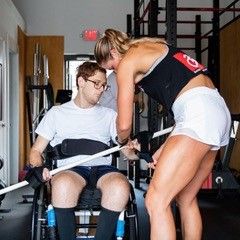
(Photo Courtesy of Kaizen Athletics)
ACE: Why do you think movement/exercise is important for those with long-term physical or traumatic impairments?
Emily: I am a strength and conditioning coach and I educate our adaptive athletes on functional fitness. Functional fitness movements are going to mimic ADLs(activities of daily living) outside of the gym. They are “natural movements” that make your activities of daily living possible. The main goal of this is to help each each athlete regain their strength, mobility and independence.
Some examples of functional movements that I coach:
- The Deadlift (mimics picking something up off the floor)
- The Air Squat (mimics getting on/off a chair, on/off the toilet)
- Cleans (picking something up and putting on a table)
- Presses (mimics putting something away in a cabinet or shelf)
- Pushups and burpees (being able to pick up your own body off the floor)
ACE: What do fitness professionals need to know before training someone with impairments?
Emily: Right now, I’m working a-lot with spinal cord injury survivors, gunshot victim survivors, stroke survivors, brain cancer survivors, amputees, and individuals with invisible wounds such as TBIs or PTSD. I pride myself on being able to modify/scale for any athlete that walks through my doors. This takes time and hours of coaching to feel comfortable working with the adaptive population. My suggestion would be to immerse yourself in continuing education. The more you can take in, observe, get hands on experience, the better coach you will be.
ACE: What do you see a lot of fitness professionals get wrong when it comes to adaptive training?
Emily: Not being prepared. If you know an adaptive athlete is coming into your gym for a class, be prepared. Know what you’re going to do for them that day. Have a lesson planned, prepared, and have any scale/modifications ready for when you start their class.
ACE: Your tuition is 100% donation based. Why did you go that route?
Emily: We made this program 100% donation based because we know the financial burden of having a physical or traumatic impairment is very costly. We wanted to take the finances out of the equation.
Our community is extremely supportive as well. They provide constant donations that we put towards the program to ensure these athletes get free classes as well as extra equipment or modalities they may need.
ACE: What other tips do you have for fitness professionals when it comes to creating a more inclusive and accessible training environment?
Emily: When creating the workout for the group class, make sure everyone is doing the same workout. Scale or modify for the athletes that need it but, always have them moving together.
I have also seen the benefits of fitness and how it affects not only their physical health but also their mental health, especially for the adaptive community. They are surrounded by other individuals in similar circumstances and they are able to vent, discuss, ask for advice or give advice, talk about medications, or struggles that they are having. These friendships are what keeps them coming back to your gym!
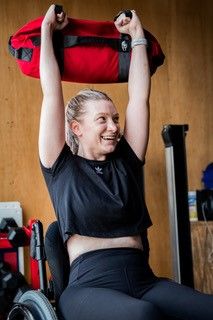
(Photo Courtesy of Kaizen Athletics)
Want to learn more about adaptive training? Check out these ACE continued education courses:
And to see more of what Emily is doing with her adaptive program at Kaizen Athletics you can visit www.kaizenathleticsvb.com.




 by
by 





